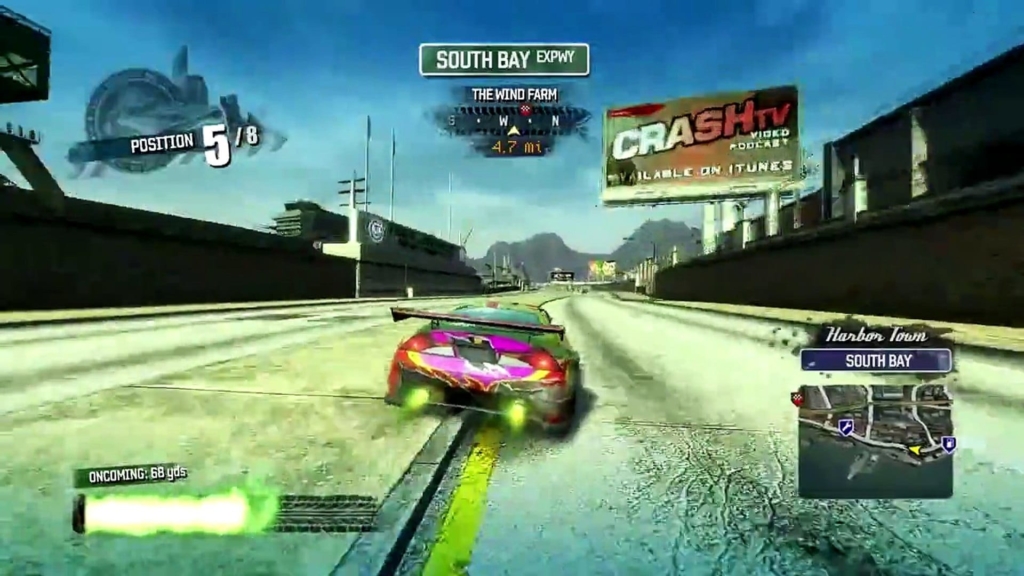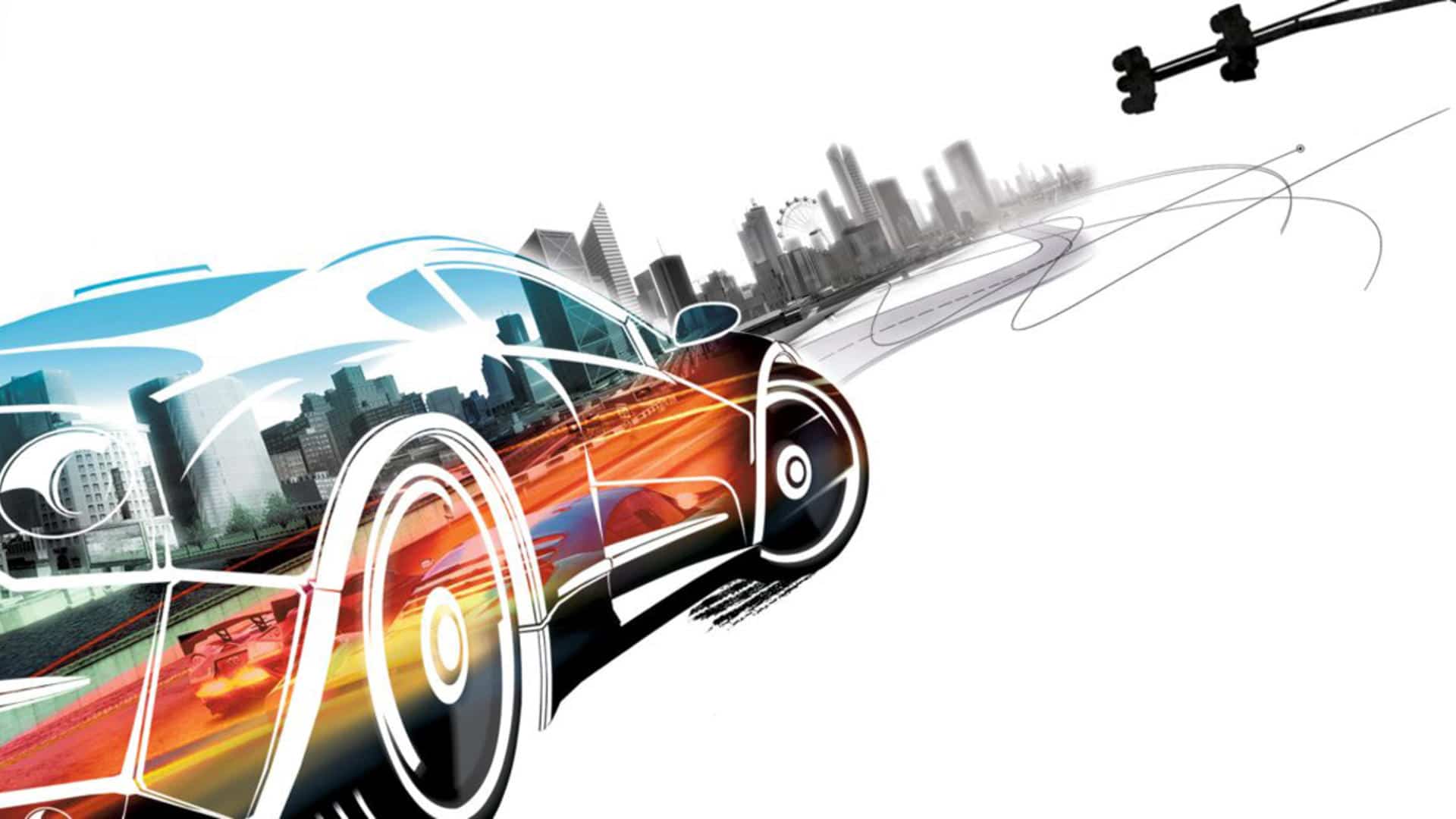Story of a Game: Burnout Paradise
Games have stories. Not just stories of how they were developed, but stories from the people that played them and the way they affected the gaming world.
In this series, Ultimate Gaming Paradise is going to bring you some of the stories of games, from headline-making triple-A titles to some indie masterpieces.
Get your seatbelt on, it’s time to go to Paradise City!
Burnout 5
Burnout was already an established series for Criterion when the PS3 and Xbox 360 came looming on the horizon and, while they didn’t dominate the racing genre in the early 2000s, there were definitely a lot of fans.
As a series, Burnout was gaining attention for its focus on fun driving over the more simulation-type games like Gran Turismo. As the series developed, more and more was put into modes where hammering your car through traffic causing as much destruction as possible were just a little more important than simply getting to the finish line first (though that was also pretty much key).
This led to major series developments such as ‘crash mode’, where you drove your car into a junction attempting to cause as much damage a possible, and ‘road rage’, where smashing other vehicles off the road is the only way to win.
When it came to their fifth release, series producer and developer Andy Ward wanted to shake things up a bit and move into an open world environment; Burnout Paradise was born.
Enjoying the city – an open world driving game
Car racing games typically were about driving on a prescribed track. Sure, the scenery changed, and ‘town’ or ‘city’ venues provided adequate backdrop with buildings, and tight turns a feature, but you always had one line to go in. Test Drive Unlimited had come out in 2006 and featured an open-world driving experience. Still, it was fairly boring for many, and the area was so vast and generally featureless that it was hard for players to really get a feel for it. Criterion, by contrast, were looking to make a map with which players could really become familiar, including memorable street names and recognisable features.
It worked really well. Exploring the world of Paradise City for the first few hours could be a little confusing, and referring back to the map was a regular time-out, but as with a real-life environment, over time, the locations would start to become embedded somewhere in the memory and players recalled them with ease, driving around the virtual environment as if they lived there.
By making the game an open world race, it differentiated massively from the previous Burnout titles, and brought a whole new concept to the game.

It also caused some contention, especially with the event system.
To join one of the many races, road rage events, or other missions, you have to drive to a marked crossroads and initiate the event. It is a smooth system that allows for in-world competitions without jumping out of the driving experience. However, the game’s original version didn’t allow you to restart an event if you were falling behind and forced you to come back to the same crossroads to try a second time. With some races driving you five minutes in the opposite direction, tracking back across the map to try again was a pain (and one which you often didn’t bother with, swapping it for another event closer to your new position).
Iain Angus, the lead gameplay programmer, noted that the choice was made by “pure bloody-mindedness from the guy in charge”, forcing the open-world realism just a little too far for most players. Later versions of the game added a restart feature after many complaints by frustrated players. “We all thought it was stupid,” continued Angus, “he just wouldn’t have any of it. So yeah, it was a poor decision.”
A poor decision for immediate gameplay, perhaps, but by focussing on the open-world experience, Burnout Paradise became more than a simple game; for many, it was an addiction, where that feeling of ‘just one more race’ would lead to hours more at the wheel. Without jumping out to a menu, it was that much harder to find a feeling of closure, and consequently, games of Burnout Paradise would stretch far beyond the planned time…
Crashing cars, and enjoying it
Unlike many other car games at the time, Burnout Paradise has no branded cars in it. While not confirmed by the developers, the word at the time was that car manufacturers didn’t like having their cars bashed and beaten and refused to allow their likenesses to be used. Compared to the Gran Turismo series, which featured impressive renders of real cars, Burnout Paradise had to make do with its own-branded rip-off versions. While this was off-putting for some players, like how people prefer Kelloggs to supermarket brand cornflakes, it was the only way to have the realistic crash detail that took the game to new heights.
Damaging cars has never been more fun!
The well-developed and well-loved ‘crash mode’ from previous Burnout games was gone, however. It didn’t fit well with the new open-world setting that was being pushed by Andy Ward and would later find a new home in its own game—Burnout Crash—that came out a while later. For this new behemoth of a racing game, the developers invented a brand new crash simulation, called ‘showtime’!
Showtime is beautiful and a test of skill no less impressive than all the racing that has been done up to this point. During showtime, the game turns into a slow-motion crash-fest, where your car flips up into the air and careens down the road doing as much damage as can be possibly done before running out of momentum and lying as a crumpled wreck on the ground. The trick comes in finding other things (mainly cars, but billboards are great, too) to bounce off and provide a little extra bonus boost as you roll down the track.
There’s no doubt about it—showtime was one of the game’s premier features and a true gamer’s delight, bringing an all-important amusing aspect to what could be otherwise thought of as a ‘serious’ game.
True trophy hunters and all-round crash-masters were able to complete insane runs of showtime destruction, with some players passing the 30-minute mark as their car crashed through the city, smashing up buses and billboards as it went.
Showtime also provided those promoting the game a way to show it off to potential customers who wanted a little more than just a basic driving game. A number of game shops across the UK ran pre-launch evenings, showing off the latest Burnout game, where they invited curious members of the public to come along and have a quick go. There’s nothing like being in a room filled with people all laughing and shouting about the level of damage done to convince you that maybe this car game is more than it first appears…
Showtime wasn’t the only way you could smash up your car in Burnout Paradise, though. General driving would do it for many, and for those with a real desire to let off some aggression, there was always Road Rage mode, where slamming people off the road was what it was all about.
There are few driving experiences better than an online multiplayer race where scraping your competition against a large concrete wall is encouraged.
Playing with friends
One of the things about groundbreaking games is that quite often, it’s hard to see where they were groundbreaking. Burnout’s desire to keep you in the game at all times meant that jumping away from the action to navigate a menu and set up a multi-player lobby was something Criterion were keen to avoid. Instead, many features are available on-screen while you drive—a quick press of the D-pad, and you can invite friends to race with you without even pulling alongside to park.

It’s a bit like fiddling with the stereo in real life—fine most of the time, but it will eventually cause a crash. Of course, in Burnout Paradise, a crash was pretty much encouraged—a real case of ‘don’t try this at home’.
Touches like that, providing seamless multiplayer access without damaging the overall play experience, is something you may take for granted in many games since. But, in 2008, it was new, and it belonged to Burnout Paradise.
The Burnout Paradise soundtrack
It takes a few different things to come together and make a good game; it takes all that and a dash of creative thinking to make a great game, but it needs fine attention to detail to make a perfect one.
An attention to detail that includes picking the right songs.
Burnout Paradise has centred on the Guns ‘n’ Roses song Paradise City. In fact, the two are tied together so closely that it’s hard to think of one without the other. Paradise City is only the beginning of an impressive soundtrack that does exactly what it is meant to—create a brilliant atmosphere and memorable soundscape to surround the play experience.
What remains is a snapshot of the music of the era, an encapsulation of the early years of the 21st Century, mixed with some classics from previous years. Matt Webster, one of the game’s producers, was particularly fond:
“To have Adam Ant and Avril Levigne in the same space… Hey you / You you / I don’t like your girlfriend is just brilliant to drive a car straight through traffic to,” he commented during one interview, and he’s not wrong.
There’s something about the vibrance of the soundtrack that adds an extra layer to the gaming experience. Far from feeling that you are sat in your living room, a few feet from a television, you instead get a sense of the open air, warm California sunshine, and a smell that mixes petrol with the sea. Paradise City may be a made-up place with its own set of street names and unusual concentration of ramps leading to billboards, but for anyone with the volume turned up and enjoying the cars whizzing past, it’s as real as whatever is going on outside.
Improving on the original
Burnout Paradise’s development didn’t stop on release, with Criterion spending a year developing DLC content to continually improve what was already a groundbreaking title. After a couple of bug fix patches, players were treated to free additional content, from added online game modes and new vehicles to improved technical developments that built on the already-impressive 60fps driving engine, adding 1080i support and weather effects.
On the free DLCs, Iain Angus shared his personal confusion:
“We spent a year doing [free] DLC—which was extremely bizarre … I never understood the business reasons for that.”
Sensible business reasons or not, it was a level of customer support that saw a lot of happy fans, keen to support the game and encourage friends to join in on the fun.
Ending on a high
Despite there being a couple of titles with the Burnout name on them that followed Paradise, this really marks the end of the series, with the team that made it now all dissolved and working on other things. This was a game that showed what arcade driving games should all be about—an emphasis on fun, a willingness to listen to the audience, and a mix of ingredients that were each freshly picked.
A decade later, 2018 brought Burnout Paradise Remastered to the PS4, Xbox One and PC platforms. An upgraded set of textures and improved lighting, Burnout Paradise Remastered includes all the DLC and ensures the game will be enjoyed for a few more years. And why not remaster it? After all, in the years since, no one has managed to better it.

